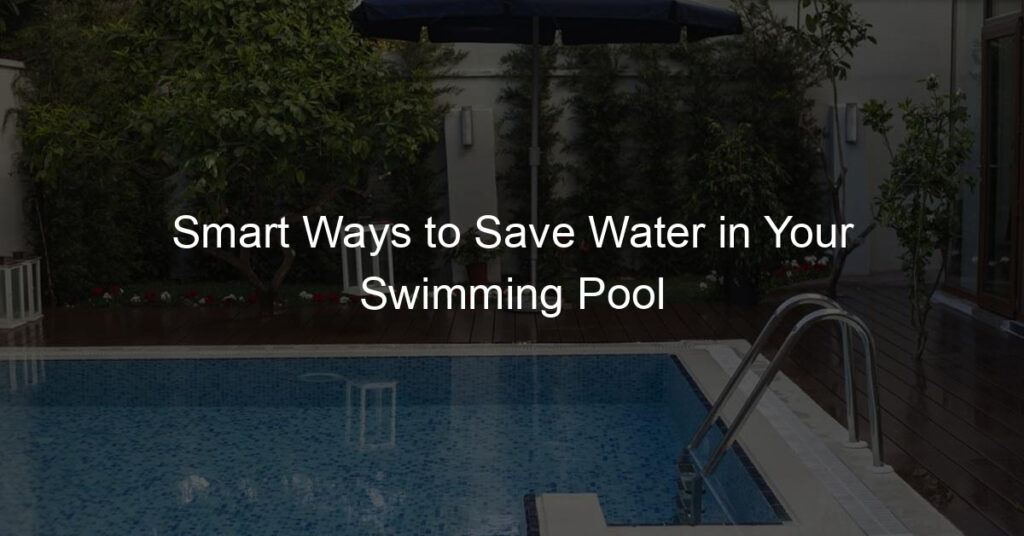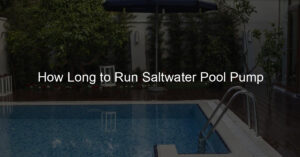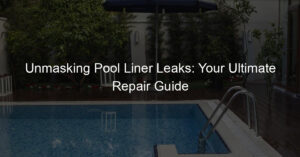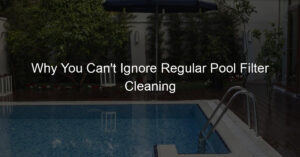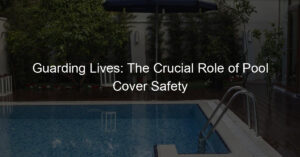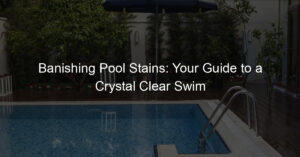Introduction to Pool Water Saving Techniques
Swimming pools are a great source of fun and relaxation, especially during the hot summer months. However, they can also consume a significant amount of water. This is where pool water saving techniques come into play. These strategies not only help conserve water but also reduce your water bills. Let’s delve into the importance of water conservation in swimming pools and understand the basics of effective pool water management.
-
- Importance of Water Conservation in Swimming Pools
Water is a precious resource, and its conservation is a responsibility we all share. In the context of swimming pools, water conservation becomes even more critical. According to the Environmental Protection Agency, an average swimming pool can lose about 1,000 gallons of water per month if not properly maintained. That’s a lot of water!
Conserving water in swimming pools not only helps protect this valuable resource but also saves you money on your water bill. It also reduces the need for chemicals to treat the water, leading to a healthier swimming environment.
-
- Understanding the Basics of Effective Pool Water Management
Effective pool water management is key to conserving water. This involves several steps, including regular pool maintenance, monitoring for leaks, and using water-saving equipment.
Regular maintenance includes tasks like cleaning the pool and checking the water levels. If the water level is too high, it can lead to unnecessary water loss through splashing and overflow. On the other hand, if the water level is too low, it can damage the pool’s pump system.
Monitoring for leaks is another crucial aspect of pool water management. Even a small leak can result in significant water loss over time. Therefore, it’s important to regularly check for signs of leaks and repair them promptly.
Finally, using water-saving equipment, such as pool covers and efficient pumps, can greatly reduce water usage. Pool covers minimize evaporation, which is the primary cause of water loss in pools. Efficient pumps, on the other hand, circulate the water more effectively, reducing the need for frequent water replacement.
Strategies for Conserving Pool Water
One of the most effective ways to conserve pool water is by reducing evaporation. Evaporation is a natural process that can lead to significant water loss in swimming pools. However, there are strategies that can help minimize this.
Reducing Evaporation
There are two main strategies for reducing evaporation in pools: using pool covers and strategic landscaping. Let’s explore these strategies in detail.
-
- Using Pool Covers
A pool cover is a simple and effective way to reduce evaporation. When a pool is not in use, covering it can prevent up to 95% of water loss due to evaporation. Pool covers come in various types, including solar covers, safety covers, and winter covers. Each type serves a different purpose but they all help in conserving water.
-
- Strategic Landscaping
Landscaping can also play a significant role in reducing evaporation. By planting trees or installing fences around the pool, you can create a windbreak that reduces the wind’s speed over the pool surface, thereby reducing evaporation. Additionally, these landscaping elements can provide shade, which lowers the pool’s temperature and further reduces evaporation.
In conclusion, reducing evaporation is a key strategy in conserving pool water. By using pool covers and strategic landscaping, you can significantly reduce water loss and contribute to water conservation efforts.
Optimizing Pool Usage
When it comes to conserving water in your swimming pool, optimizing how you use your pool can make a significant difference. Here are two key strategies you can implement:
- Limiting Splash-Out and Overflow
One of the simplest ways to reduce water waste is by limiting the amount of water that splashes out of the pool. This can be achieved by encouraging swimmers to enter and exit the pool gently, and by avoiding activities that cause a lot of splashing.
Overflow can also lead to significant water loss. To prevent this, ensure that the water level in your pool is not too high. The water level should be halfway up the pool skimmer opening for optimal performance.
- Managing Pool Temperature
Did you know that the temperature of your pool can affect water conservation? Warmer water evaporates more quickly than cooler water. Therefore, by managing the temperature of your pool, you can reduce the rate of evaporation and save water.
Consider setting your pool heater to a lower temperature, especially when the pool is not in use. Remember, every degree counts when it comes to saving water!
Implementing these strategies can help you optimize your pool usage and contribute significantly to water conservation. Remember, every drop counts!
| Strategy | Description | Impact on Water Conservation |
|---|---|---|
| Limiting Splash-Out and Overflow | Encourage gentle entry and exit from the pool, avoid activities that cause a lot of splashing, and maintain appropriate water level. | Reduces water waste due to splash-out and overflow. |
| Managing Pool Temperature | Set your pool heater to a lower temperature, especially when the pool is not in use. | Reduces rate of evaporation, thereby saving water. |
Water Conservation in Swimming Pool Maintenance
When it comes to conserving water, swimming pool maintenance plays a crucial role. By implementing regular checkups and repairs, we can significantly reduce water wastage and promote sustainability. Let’s delve into how we can achieve this.
Regular Checkups and Repairs
Regular checkups and timely repairs are essential to maintaining the health of your swimming pool and conserving water. There are two key areas to focus on:
-
- Identifying and Fixing Leaks
Leaks in your swimming pool can lead to a significant waste of water. It’s estimated that a small leak can result in thousands of gallons of water lost each year. Regular inspections can help identify any potential leaks early, allowing for prompt repairs. This not only saves water but also prevents damage to the pool structure.
-
- Regularly Cleaning Filters
Pool filters play a vital role in maintaining the cleanliness of your pool water. However, if not cleaned regularly, they can become clogged and inefficient, leading to more water being used to clean the pool. Regular cleaning of filters ensures they work efficiently, reducing the need for excessive water usage.
In conclusion, regular checkups and repairs are a vital part of water conservation in swimming pool maintenance. By identifying and fixing leaks and cleaning filters regularly, we can significantly reduce water usage and contribute to a more sustainable environment.
Water-Efficient Equipment
When it comes to conserving water in your swimming pool, investing in water-efficient equipment is a smart move. This includes using efficient pumps and heaters, as well as investing in a water-saving pool filter. Let’s take a closer look at these options.
- Using Efficient Pumps and Heaters
Efficient pumps and heaters can make a big difference in your water consumption. These devices are designed to use less water while still providing the same level of performance. For example, a high-efficiency pool pump can save up to 20% more water compared to standard pumps. Similarly, energy-efficient heaters can reduce water evaporation, which is a major cause of water loss in pools.
- Investing in a Water-Saving Pool Filter
A water-saving pool filter is another excellent investment for water conservation. Traditional filters often require backwashing, which can waste a significant amount of water. On the other hand, water-saving filters are designed to minimize this need, thus conserving water. Some studies have shown that these filters can save up to 25% more water compared to traditional ones.
| Equipment | Water Savings |
|---|---|
| High-efficiency pool pump | Up to 20% more water |
| Energy-efficient heater | Reduces water evaporation |
| Water-saving pool filter | Up to 25% more water |
In conclusion, using water-efficient equipment is a key strategy in conserving pool water. By making these smart investments, you can enjoy your pool while also doing your part to conserve water.
Techniques for Reducing Pool Water Usage
One of the most effective ways to reduce pool water usage is through water recycling. This approach not only conserves water but also saves money on your water bills. Let’s explore two simple yet effective water recycling techniques.
Water Recycling
Water recycling involves reusing treated wastewater for beneficial purposes such as agricultural and landscape irrigation, industrial processes, and replenishing a ground water basin. In the context of swimming pools, there are two main ways to recycle water:
-
- Using Rainwater Collection Systems
Rainwater collection systems are a great way to conserve water. These systems collect rainwater that falls on your roof and store it in a tank. This stored water can then be used to fill your pool, reducing the need for fresh water. According to a case study, a typical rainwater collection system can save up to 40% of a household’s water usage.
-
- Backwashing Less Often
Backwashing is a process that cleans your pool’s filter by reversing the flow of water. While this is a necessary part of pool maintenance, it can use a lot of water. By backwashing less often, you can significantly reduce your pool’s water usage. For example, if you currently backwash once a week, consider doing it once every two weeks instead. This simple change can save thousands of gallons of water each year.
By implementing these water recycling techniques, you can significantly reduce your pool’s water usage while still maintaining a clean and healthy swimming environment.
Chemical Management
Managing the chemicals in your pool is a crucial part of reducing water usage. It’s not just about using less water, but also about using the right kind of chemicals. Let’s take a closer look at how you can do this.
-
- Using chemicals sparingly
Chemicals are necessary for keeping your pool clean and safe, but they should be used sparingly. Overuse of chemicals can lead to a need for more frequent water changes, which wastes water. By using just the right amount, you can maintain a clean pool and conserve water at the same time. For example, instead of adding chemicals every day, you might find that every other day is sufficient. This can reduce your water usage by up to 50% over the course of a year.
-
- Choosing eco-friendly alternatives
Another way to manage your pool chemicals is to choose eco-friendly alternatives. These are products that are designed to be less harmful to the environment, and they often require less water to use effectively. For instance, there are eco-friendly pool sanitizers that use natural minerals instead of harsh chemicals. These can be just as effective at keeping your pool clean, but they require less frequent water changes. This can save you hundreds of gallons of water each year.
In conclusion, managing your pool chemicals is a key part of reducing water usage. By using chemicals sparingly and choosing eco-friendly alternatives, you can make a big difference in your water consumption. So, the next time you’re maintaining your pool, remember these tips and make a positive impact on the environment.
Sustainable Swimming Pool Practices
One of the most effective ways to conserve water in swimming pools is by adopting sustainable practices. These practices not only save water but also create a healthier and more enjoyable swimming environment. Let’s delve into the importance of education and awareness in promoting sustainable swimming pool practices.
Education and Awareness
Education and awareness play a crucial role in promoting sustainable swimming pool practices. By educating pool users and implementing certain rules, we can significantly reduce water wastage. Let’s explore these two aspects in detail.
-
- Teaching Pool Users About Water Conservation
Knowledge is power. The first step towards water conservation in swimming pools is educating the users about its importance. This can be done through informative sessions, distributing pamphlets, or displaying informative signs around the pool area. It’s essential to explain how water conservation benefits not only the environment but also reduces maintenance costs.
-
- Implementing Pool Rules to Save Water
Implementing certain pool rules can greatly assist in water conservation. These rules might include avoiding overfilling the pool, encouraging swimmers to take short showers before entering the pool, and discouraging water games that result in water splashing out of the pool. These rules, when followed strictly, can lead to significant water savings.
In conclusion, education and awareness are key in promoting sustainable swimming pool practices. By teaching pool users about water conservation and implementing pool rules to save water, we can make a big difference in our water usage. Remember, every drop counts!
Water Efficiency in Swimming Pools
Water efficiency is a crucial aspect of sustainable swimming pool practices. By monitoring water levels and using pool water testing kits, you can significantly reduce water usage and contribute to environmental conservation. Let’s delve into these two techniques:
- Monitoring Water Levels
Regularly checking your pool’s water level is a simple yet effective way to conserve water. A drop in water level might indicate a leak, which can lead to significant water loss if not addressed promptly. According to the American Water Works Association, a small leak in a pool can waste about 1,000 gallons of water per month. By maintaining a consistent water level, you not only save water but also ensure the proper functioning of your pool’s equipment.
- Using Pool Water Testing Kits
Pool water testing kits are essential tools for maintaining water efficiency. These kits allow you to measure various parameters such as pH, chlorine, and alkalinity levels. Maintaining these levels within the recommended range ensures the water remains clean and clear, reducing the need for frequent water replacement. For instance, a pool with balanced pH levels (between 7.2 and 7.6) requires less chlorine, thereby reducing water pollution and the need for water replacement.
In conclusion, monitoring water levels and using pool water testing kits are effective strategies for enhancing water efficiency in swimming pools. By implementing these practices, you can contribute to water conservation and promote sustainable swimming pool practices.
Conclusion: Saving Water in Your Pool
As we wrap up our discussion on pool water conservation, let’s take a moment to review the key takeaways and understand the importance of regular pool maintenance and water conservation.
- Review of Key Takeaways
We’ve learned a lot about how to save water in your pool. Here’s a quick recap:
- Pool covers are essential. They reduce evaporation, which is the leading cause of water loss in pools.
- Regular checks for leaks can save gallons of water. A small leak can lead to a significant loss over time.
- Using a pool water leveler can help maintain the right water level and prevent overfilling.
- Backwashing filters only when necessary can save a lot of water.
- Planting windbreaks around the pool can reduce evaporation caused by wind.
- Importance of Regular Pool Maintenance and Water Conservation
Regular pool maintenance is not just about keeping the pool clean. It’s also about conserving water. Every drop of water we save is a contribution to our environment. Remember, water is a precious resource, and we should use it wisely.
By implementing the strategies and techniques we’ve discussed, you can significantly reduce your pool’s water usage. Not only will this save you money on your water bill, but it will also help conserve our planet’s most valuable resource.
So, let’s all do our part in saving water in our pools. Every drop counts!

